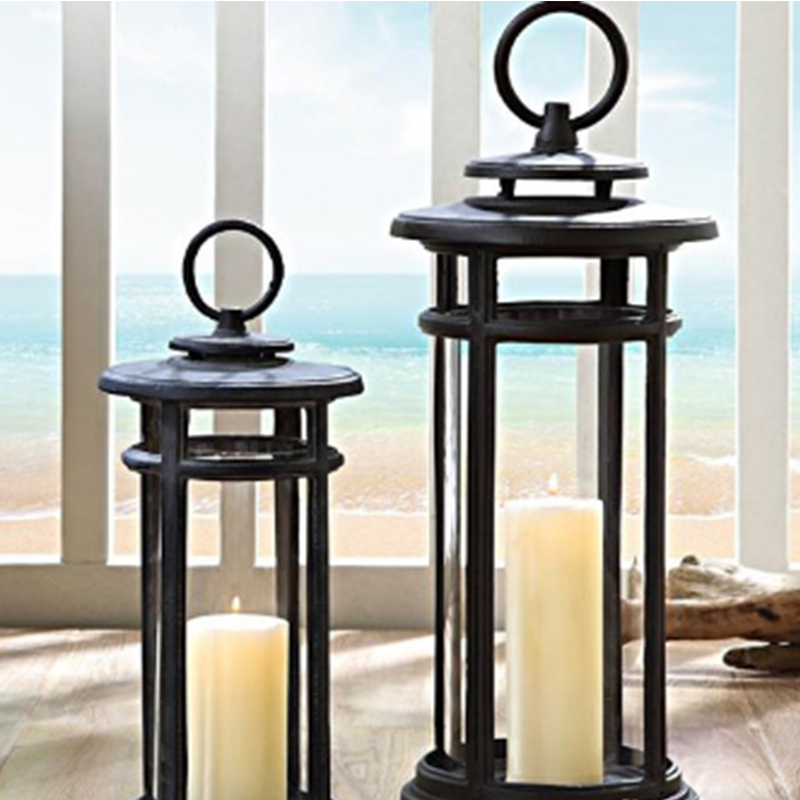How to optimize the design of GLASS WIND LANTERN to improve wind resistance?
Optimizing the design of GLASS WIND LANTERN to improve wind resistance requires structural design, material selection, ventilation system optimization, and overall stability. The following are specific optimization methods and strategies:
1. Lampshade shape and aerodynamic optimization
(1) Streamlined design
Principle: The streamlined lampshade can reduce wind resistance and prevent strong winds from directly impacting the lamp body.
Implementation:
Design the lampshade to be cylindrical or spherical to reduce sharp corners and reduce the impact of wind pressure on the lamp body.
Add an arc or slope design to the top of the lampshade to guide the wind around the lamp body.
(2) Layered structure
Principle: The layered lampshade can form a protective barrier inside to prevent strong winds from blowing in directly.
Implementation:
Design a double-layer or multi-layer lampshade structure, with the outer layer used to block the wind and the inner layer used to protect the light source.
Leave an appropriate gap between the inner and outer layers to form an air buffer zone.
2. Base and center of gravity optimization
(1) Weighted base
Principle: Increasing the weight of the base can improve the overall stability of the lantern and prevent it from tipping over.
Implementation:
Use high-density materials (such as metal, concrete or stone) to make the base.
Add counterweights inside the base so that users can adjust the weight as needed.
(2) Low center of gravity design
Principle: Lowering the center of gravity can enhance the lantern's ability to resist tipping over.
Implementation:
Design the base to be wider and thicker and ensure that it is located at the center of the bottom of the lantern body.
Place heavier components (such as batteries or lamp drivers) inside the lantern body to further lower the center of gravity.
3. Fixing and anti-slip measures
(1) Anti-slip pad
Principle: Anti-slip pads can increase the friction between the lantern and the ground to prevent sliding or tipping over.
Implementation:
Install a rubber or silicone anti-slip pad at the bottom of the base.
The surface of the anti-slip pad is designed to be corrugated or concave and convex to further improve grip.
(2) Fixing device
Principle: Enhance the stability of the wind lamp through external fixing devices.
Implementation:
Design bolt holes on the base to allow users to fix the wind lamp to the ground or table with screws.
Provide detachable ground nails or brackets for fixing the wind lamp to the ground when used outdoors.
4. Ventilation system optimization
(1) Reasonable layout of ventilation holes
Principle: Ventilation holes can improve air circulation inside the lamp body and prevent strong wind from blowing directly on the light source.
Implementation:
Symmetrical ventilation holes are set at the top and bottom of the lampshade to form natural convection and reduce internal heat accumulation.
The ventilation holes are designed in an inclined or curved shape to prevent rain and strong wind from directly entering.
(2) Air duct design
Principle: Optimizing the air duct can guide the airflow to bypass the light source and reduce the impact of wind on the lamp body.
Implementation:
Add wind deflectors or partitions inside the lampshade to guide the airflow along a specific path.
Ensure that the width of the air duct is moderate, which can effectively dissipate heat without allowing strong wind to directly hit the light source.
5. Material selection and protective measures
(1) High-strength glass
Principle: High-strength glass can withstand greater wind pressure and mechanical stress.
Implementation:
Use tempered glass or laminated glass to make lampshades to improve impact resistance.
Add wind-resistant coatings (such as nano-coatings) on the glass surface to reduce wind and sand erosion.
(2) Weather-resistant materials
Principle: Weather-resistant materials can extend the service life of wind lamps in harsh environments.
Implementation:
Use corrosion-resistant and oxidation-resistant metal materials (such as stainless steel or aluminum alloy) to make lamp stands and bases.
Surface treatment of metal parts (such as anodizing or spraying anti-corrosion coatings) to enhance wind erosion resistance.
6. Experimental verification and optimization
(1) Wind tunnel test
Principle: Simulate the performance of wind lamps under different wind speed conditions through wind tunnel experiments.
Implementation:
Test the force distribution of the lamp body at different angles and wind speeds to find out the areas that are easily affected by wind.
Adjust the shape of the lampshade, the weight of the base, and the layout of the ventilation holes based on the test results.
(2) Actual scenario testing
Principle: Verify the wind resistance of the wind lamp in a real environment.
Implementation:
Carry out field tests at places with strong winds, such as the seaside and the top of a mountain, to record the stability and durability of the wind lamp.
Collect user feedback and make improvements based on actual problems.
The above methods can significantly improve the wind resistance of the glass wind lamp while ensuring its aesthetics, meeting the needs of users in various environments.


 English
English Español
Español












